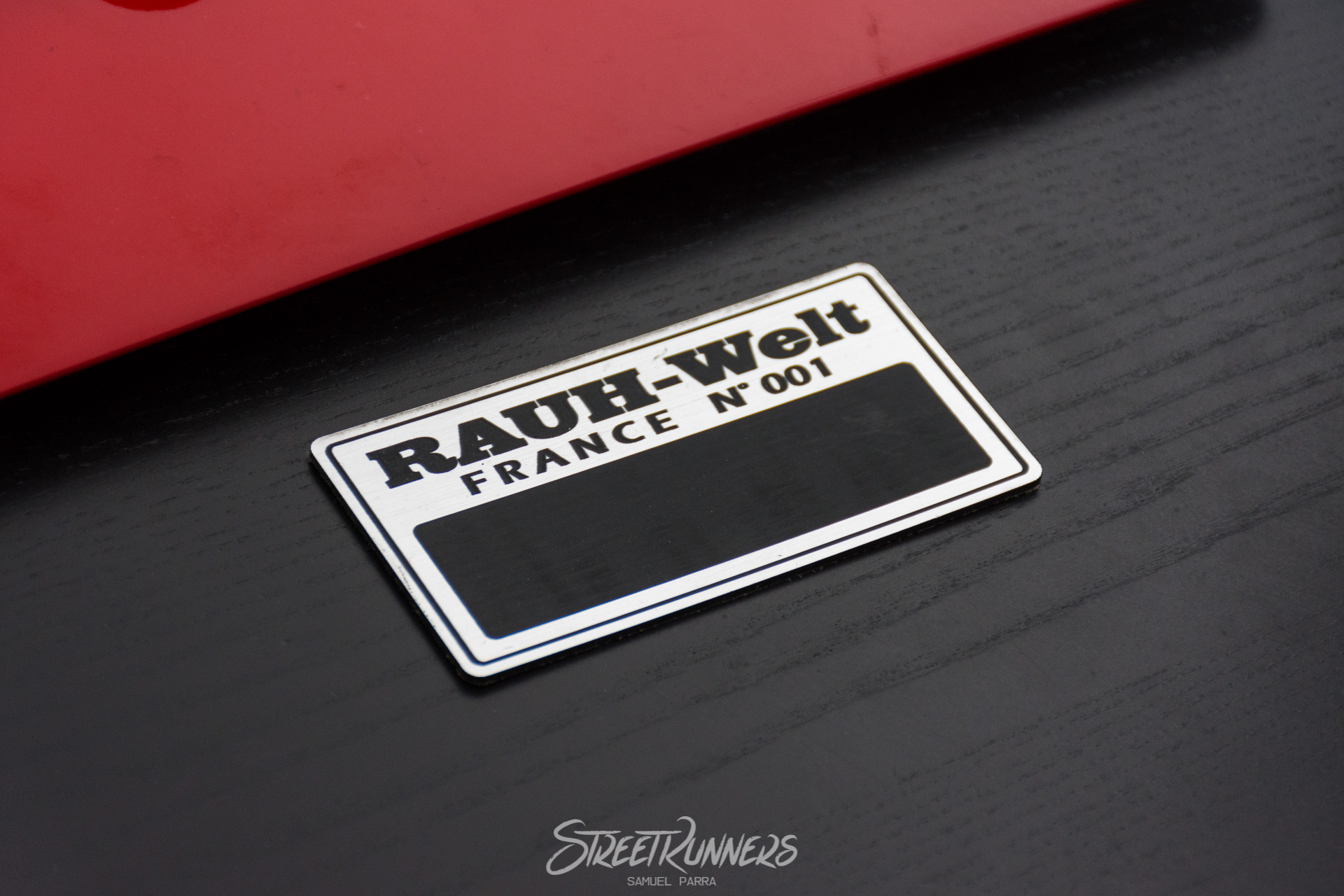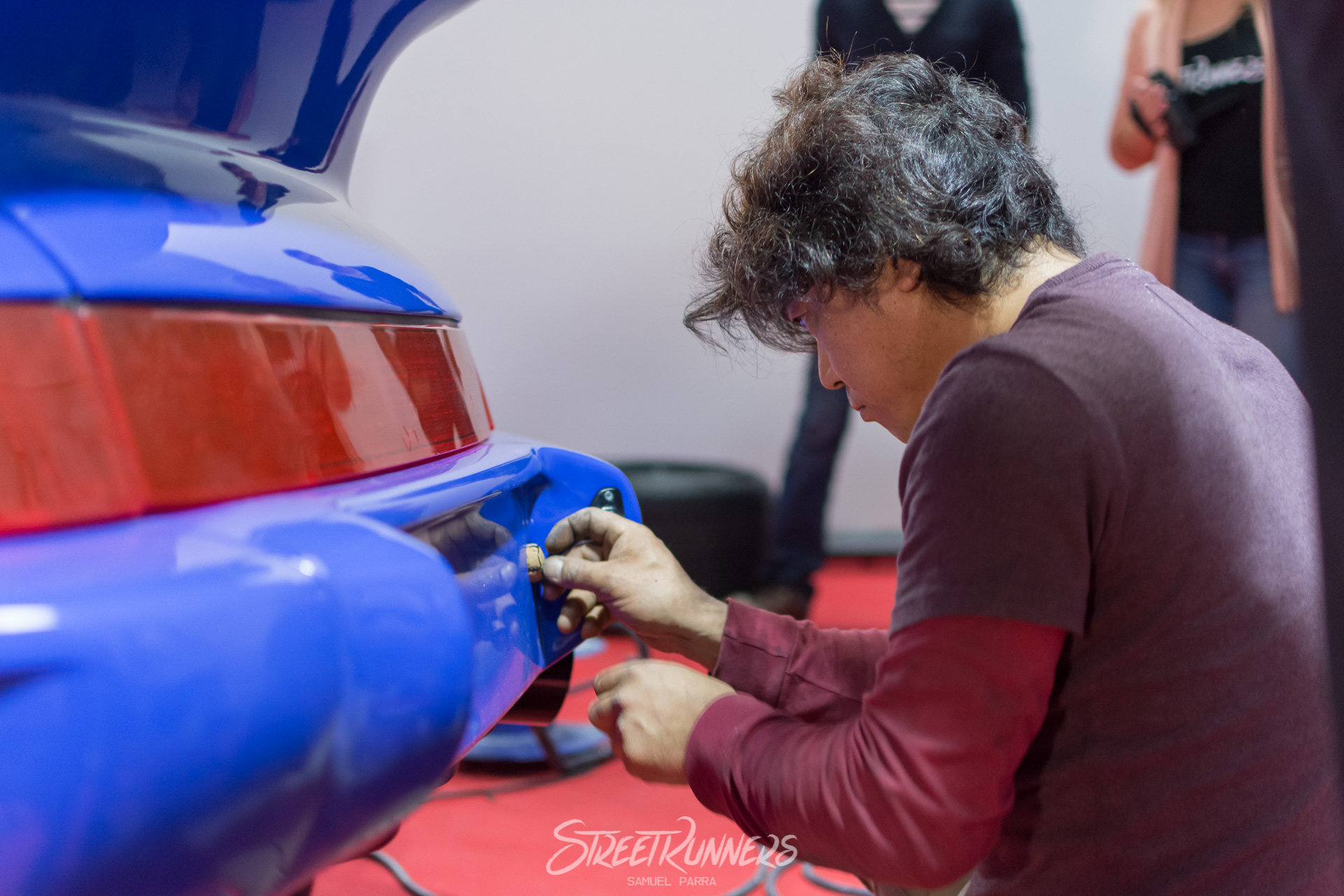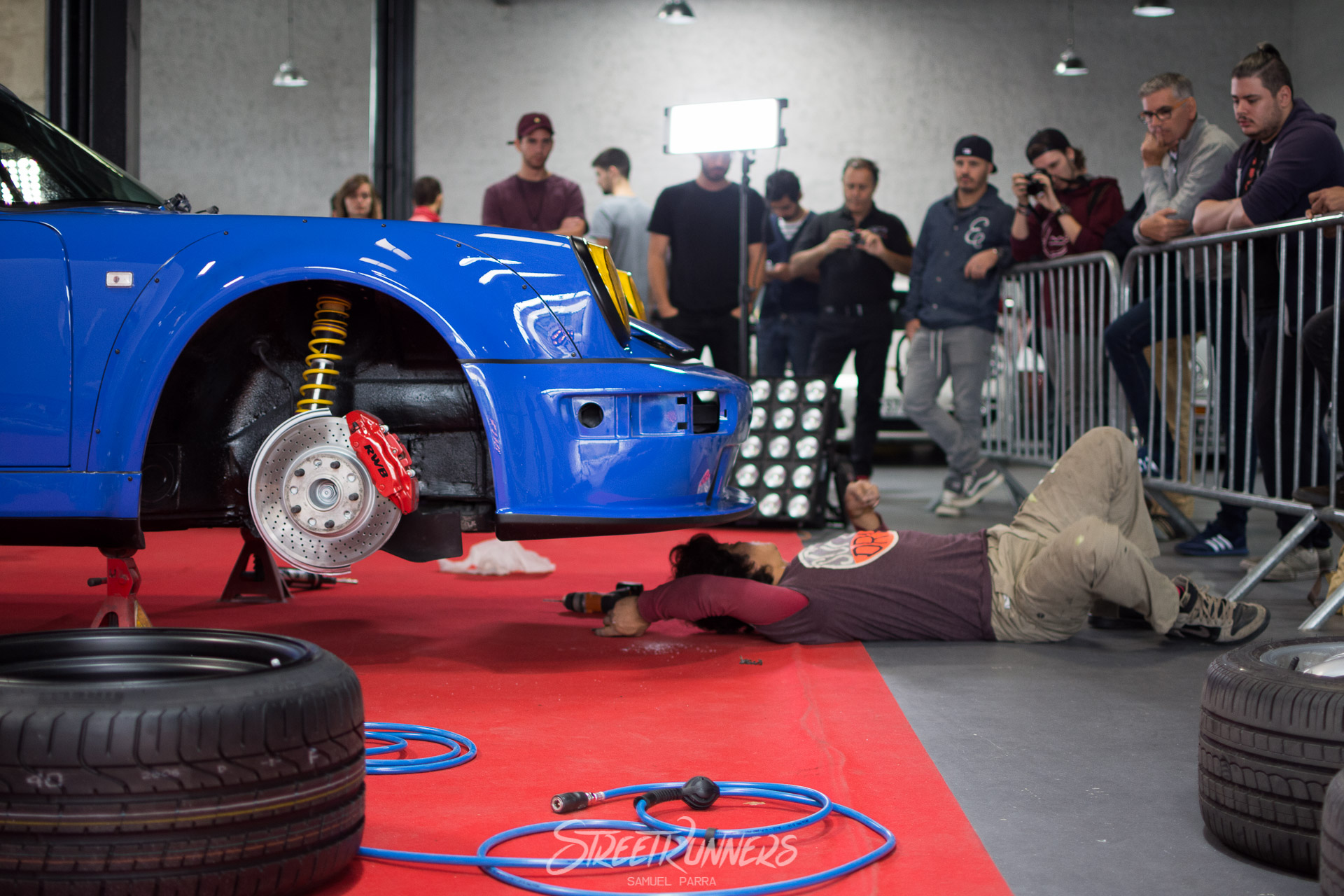RWB France #1 - "Champagne"
- Samuel Parra
A year ago I traveled to London, where I saw an RWB for the first time. It was also the first time I met Nakai-san.
By that time, Adrian was in the same situation as me. He had spent years seeing pics and videos of 911’s modified by Nakai-san on the Internet, and when he learned that he was going to the UK, just an hour away from his natal France by plane, he decided that he could not let the opportunity of watching him work pass. He started studying English on his own, bought a plane ticket to London and headed to Profusion Customs, where he witnessed how Hibiki was born.
That’s where I met him. A quiet guy who could barely speak English, but didn’t even blink while watching Nakai-san work. During those three days we talked a bit, and between English, French and sign language we managed to understand each other: he had come to the workshop with a clear idea in his mind, he wanted RAUH-Welt France to become a reality, and he wanted to be the one to accomplish it. After some conversations with Nakai-san, they decided to work on the details at a later date, but the most difficult thing was already done: the master had said yes to his dream.
I didn’t hear about Adrian until some months later, while I was in Kashiwa, Japan. After I posted some Instagram stories while I was at the RWB headquarters I got a message from him asking for help, as he had sent several emails to RWB’s international director, Toshiya Ichiraku, but hadn’t heard back from him, and he wanted me to ask him about it face to face. What’s surprising is that I was sitting just next to him when I read those messages, so I gave Toshi-san his contact details and I waited.
Looks that everything went better than expected, as some weeks ago Adrian told me that he, together with his two business partners, Mat and Herv, had bought a 964 Carrera 4 coupé, and what’s even better, it didn’t have an electric sunroof (I’ve always had a soft spot for those). On top of that, they had plans to install the RWB Super Wide kit, which, contrary to what its name suggests, is the narrowest of the two kits the brand offers for the 964. They had decided to go for a race look by ordering the GT-Wing, inspired by the 911 RSR.
When you have your base car ready and your kit is ordered, the countdown begins. What you do during this time
will determine if your RWB is truly special or just another widebody 911. In this case, Adrian didn’t waste any time:
 Even though there are many different options with regards to RWB styling (different width overfenders, wings,
ducktails…) all of the cars have a “signature” body silhouette. But, as they say, the devil is in the details.
Between UK, France, Germany and Japan I must have seen about 20 RWBs in person, and I have to say that the amount of
small details and modifications which were done by Adrian himself on this car make it one of my favorites.
Even though there are many different options with regards to RWB styling (different width overfenders, wings,
ducktails…) all of the cars have a “signature” body silhouette. But, as they say, the devil is in the details.
Between UK, France, Germany and Japan I must have seen about 20 RWBs in person, and I have to say that the amount of
small details and modifications which were done by Adrian himself on this car make it one of my favorites.
When we arrived at the place the car was being built, it was already prepared for the master to start working on it,
without bumpers and the RWB kit laying on one side, ready to be installed.
 On the outside, the first thing that stands out is the original Porsche color, Maritime Blue, which works very well
with the yellow classic headlights (which, by the way, are legal in France!) that have been installed. Some accents in
matte black on the lower part of the side skirts, the air ducts under the headlights and the engine cover give this car
a distinguished look. On the inside, a custom roll cage painted in red which matches the seatbelts is the icing on the
cake of the color combination their owners were after: blue, red, black.
On the outside, the first thing that stands out is the original Porsche color, Maritime Blue, which works very well
with the yellow classic headlights (which, by the way, are legal in France!) that have been installed. Some accents in
matte black on the lower part of the side skirts, the air ducts under the headlights and the engine cover give this car
a distinguished look. On the inside, a custom roll cage painted in red which matches the seatbelts is the icing on the
cake of the color combination their owners were after: blue, red, black.
 Other small things that make this build stand out are custom stitched 996 GT3 seats, which have been retrofitted
together with its full braking system kit. No original Porsche badges can be seen on the car, neither on the body or on
its Work wheels: they have all been replaced by a modified RWB one. There’s also a mechanical bypass system to modify
the exhaust sound from the inside.
Other small things that make this build stand out are custom stitched 996 GT3 seats, which have been retrofitted
together with its full braking system kit. No original Porsche badges can be seen on the car, neither on the body or on
its Work wheels: they have all been replaced by a modified RWB one. There’s also a mechanical bypass system to modify
the exhaust sound from the inside.

 Silent as always, Nakai-san started working straight after he arrived to the workshop, without most of the people there
even noticing. After years installing these kits around the world, he’s capable of building a car in just under two
days. A year ago, in London, it took him three days to finish.
Silent as always, Nakai-san started working straight after he arrived to the workshop, without most of the people there
even noticing. After years installing these kits around the world, he’s capable of building a car in just under two
days. A year ago, in London, it took him three days to finish.
 Some last minute adjustments with the belt sander on the bumpers and Nakai-san puts them on the car. He’ll use these as
a guide for the overfenders which make the car look like a true RWB and marks their position with some tape to start
cutting -without any hesitation- the four stock fenders and give some room to the enormous tyres that the car will use
from then on. A cool detail is that he always likes to let the owner finish one of the cuts, and in this case, Adrian
jumped straight to it when he had the opportunity to do so.
Some last minute adjustments with the belt sander on the bumpers and Nakai-san puts them on the car. He’ll use these as
a guide for the overfenders which make the car look like a true RWB and marks their position with some tape to start
cutting -without any hesitation- the four stock fenders and give some room to the enormous tyres that the car will use
from then on. A cool detail is that he always likes to let the owner finish one of the cuts, and in this case, Adrian
jumped straight to it when he had the opportunity to do so.

 With both bumpers on and the overfenders position already marked, he installs them with only a couple of screws to
check that everything lines up correctly and then moves to the side skirts.
With both bumpers on and the overfenders position already marked, he installs them with only a couple of screws to
check that everything lines up correctly and then moves to the side skirts.
People usually don’t pay much attention to these, but they’re one of the key pieces of the kit, and one of the most difficult to install too. They consist on various sections that need to be installed in a certain order one on top of the other, and Nakai-san spends a lot of time adjusting everything to the milimeter.
 As far as I know, nobody in Europe has installed the Hakama side skirts, offered as an extra option, yet. They make
the car look even lower, but that has a price, and that means the driver has to be extra careful when he’s driving as
they will be easily scratched on every small bump on the road.
As far as I know, nobody in Europe has installed the Hakama side skirts, offered as an extra option, yet. They make
the car look even lower, but that has a price, and that means the driver has to be extra careful when he’s driving as
they will be easily scratched on every small bump on the road.
However, not installing those doesn’t mean the car looks dull. After fitting all the overfenders hardware, he puts
some Sikaflex sealant on the unions with the body, which gives the car the classic RWB look.

 Together with when he cuts the fenders, this is the most iconic moment of his builds, and nobody wants to miss it.
Together with when he cuts the fenders, this is the most iconic moment of his builds, and nobody wants to miss it.
 With the whole kit already on, Nakai-san installs the wheels for the first time and puts the car on the floor. It’s now
time to adjust the suspension and geometries, and he does it old school: alignment using only masking tape and
measuring tape.
With the whole kit already on, Nakai-san installs the wheels for the first time and puts the car on the floor. It’s now
time to adjust the suspension and geometries, and he does it old school: alignment using only masking tape and
measuring tape.
These cars are more than 20 years old, and during his travels Nakai-san has seen 911s in almost every condition
possible while installing his kits. Fortunately, this time the base car was in good shape and he didn’t have to do a
lot of adjustments to the suspension, so he finished earlier than expected.
 He then focused on Pure Poison, the Belgian RWB, in which he came to France together with the owner, Jordane.
During their trip, he felt that something wasn’t quite OK in the suspension, so he lifted the car and after removing
one of the rear wheels he saw the problem: one of the bolts which support the lower control arms had snapped, so he
fixed it on the go.
He then focused on Pure Poison, the Belgian RWB, in which he came to France together with the owner, Jordane.
During their trip, he felt that something wasn’t quite OK in the suspension, so he lifted the car and after removing
one of the rear wheels he saw the problem: one of the bolts which support the lower control arms had snapped, so he
fixed it on the go.
 This time he left the wing install for the end, and after checking that everything was perfectly aligned, he drilled
the engine cover to install the wing feet.
This time he left the wing install for the end, and after checking that everything was perfectly aligned, he drilled
the engine cover to install the wing feet.
 As the very last thing, he put the classic RAUH-Welt banner on the windshield, which was peeled by the new owners of
the car.
As the very last thing, he put the classic RAUH-Welt banner on the windshield, which was peeled by the new owners of
the car.

 This time they were the ones to name the car: Champagne. Nakai-san wanted to pay homage to it by giving the car a
special, improvised touch: a champagne bottle cork as the rear tow hook cover.
This time they were the ones to name the car: Champagne. Nakai-san wanted to pay homage to it by giving the car a
special, improvised touch: a champagne bottle cork as the rear tow hook cover.
 And with all of this, the main event came to an end. Once the visitors had already left, the video team took advantage
of the more familiar ambience to record a small interview for the official video they are preparing. Even though
Nakai-san speaks english well, they decided to do all of their questions in japanese and translate it later, which I
think was a good choice. He is a man of few words, but you can see that he is much more relaxed and open when the
interviews are done in his mother language.
And with all of this, the main event came to an end. Once the visitors had already left, the video team took advantage
of the more familiar ambience to record a small interview for the official video they are preparing. Even though
Nakai-san speaks english well, they decided to do all of their questions in japanese and translate it later, which I
think was a good choice. He is a man of few words, but you can see that he is much more relaxed and open when the
interviews are done in his mother language.
 During our last dinner with the RWB team we were able to catch up with the friends we’ve made during the last year.
Nakai-san also told us about the brand’s plan for Europe: there will soon be RWB presence in Italy and Turkey. The net
is being tightened around Spain, and maybe it’s about time a new pin is added to the RAUH-Welt Begriff map of the world…
During our last dinner with the RWB team we were able to catch up with the friends we’ve made during the last year.
Nakai-san also told us about the brand’s plan for Europe: there will soon be RWB presence in Italy and Turkey. The net
is being tightened around Spain, and maybe it’s about time a new pin is added to the RAUH-Welt Begriff map of the world…















